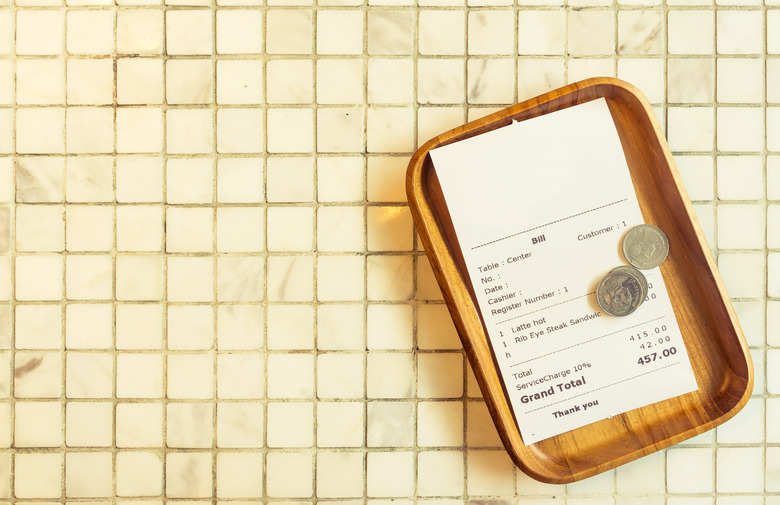How To Calculate The Percent Of Something
Whether you want to work out an appropriate tip at a restaurant, find out what percentage discount you're receiving on a product or determine what a specific percentage of a number is, the need to know how to find the percent of something comes up regularly. To calculate percent values, you need to understand what percentage really means. Converting between decimal proportions and percentages is simple, but it also makes it really easy to estimate simple percentages and perform more complicated calculations.
TL;DR (Too Long; Didn't Read)
Find the percentage of one number in relation to another with the formula Percentage = (number you want to find the percentage for ÷ total) × 100. Move the decimal point two places to the right to convert from a decimal to a percentage, and two places to the left to convert from a percentage to a decimal. To find a percentage of a number, convert the percentage to a decimal and then multiply this by the original number.
Calculating Basic Percentages
Calculating Basic Percentages
A percentage is really a number telling you how many of a specific thing per hundred (i.e., per cent, in Latin) there is. There are two main steps to follow when you're working what percentage one number is of another. For example, if you got a score of 36 out of 60 on a test, what percentage did you get? The first step is to divide the number you have by the number you want it as a percentage of. So in this case:
\(36 ÷ 60 = 0.6\)
This is the proportion of the total mark you received, with a maximum of 1 (for a score of 60 out of 60). In other words, this is the amount you got "per one." So for every mark available, you got 0.6 marks. The percentage score is the amount you got per hundred. This means all you need to do is multiply this result by 100 to get the percentage:
\(\text{Score as a percent} = \text{score as a proportion} × 100\)
Or using the example:
\(\text{Score as a percent} = 0.6 × 100 = 60 \%\)
So the score on the test as a percentage is 60 percent. The whole rule is:
\(\text{Percentage} = \frac{\text{number you want as a percentage}}{\text{total}} × 100\)
As another example, if five students out of 15 have brown eyes, what is the percentage of students who have brown eyes? Using the rule gives:
\(\text{Percentage} = \frac{5}{15} × 100 = 33.3 \%\)
Converting From Percentages to Decimals and Back
Converting From Percentages to Decimals and Back
To convert from a decimal to a percentage, multiply the decimal by 100. This means moving the decimal point two places to the right. For example, 0.4 as a percentage is 40 percent, and 0.99 as a percentage is 99 percent.
To convert from a percentage to a decimal, divide the percentage by 100. This means 23 percent is 0.23 and 50 percent is 0.5. You can think about this as moving the decimal point two places to the left.
In some cases, it's easy to express a percentage as a fraction too. A percentage is really the numerator in a fraction where the denominator is 100. So 25 percent is really 25/100. In cases like this, the fraction is easy to simplify: 25 percent is really 1/4, and 30 percent is really 3/10. This can be useful for working out a specific percent of a number in your head.
Finding a Specific Percentage of a Number
Finding a Specific Percentage of a Number
If you want to save 25 percent of everything you earn, how much do you need to take out of a $160 paycheck? Working out a specific percent of a number for situations like this is easy. First, convert the percentage you want into a fraction or a decimal. So in this case,
\(25 \%= 0.25 = \frac{1}{4}\)
Then multiply the decimal or fraction by the number you want the percentage of. For a $160 paycheck:
\(0.25 × \$160 = \$40\)
You can do this to find percentages of any number.
Percent Increase or Decrease
Percent Increase or Decrease
To work out the percentage change in a specific number, follow two steps. For example, imagine that an item is usually $50, but it's currently available for $45. First, find the total change in the amount. Do this by subtracting the old value from the new one. In the example, $45 − $50 = −$5. Here, the minus sign indicates that the price has decreased. Then use the method in the first section to work out what percentage of the original price this is. In the example:
\(\frac{−\$5}{\$50} × 100 = −10 \%\)
Therefore, there has been a 10 percent reduction in price.
If the price had increased from $50 to $55, the first step would have led to a positive result ($5) instead of a negative one. The final calculation would have then given: ($5 ÷ $50) × 100 = 10 percent, with the positive result showing an increase in price.
Cite This Article
MLA
Johnson, Lee. "How To Calculate The Percent Of Something" sciencing.com, https://www.sciencing.com/calculate-percent-something-8054846/. 27 October 2020.
APA
Johnson, Lee. (2020, October 27). How To Calculate The Percent Of Something. sciencing.com. Retrieved from https://www.sciencing.com/calculate-percent-something-8054846/
Chicago
Johnson, Lee. How To Calculate The Percent Of Something last modified March 24, 2022. https://www.sciencing.com/calculate-percent-something-8054846/
